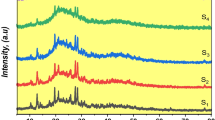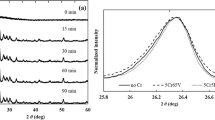Abstract
In this study, the impact of substituting an intermediate oxide, Fe2O3, for a former glass network oxide, B2O3, on the structure and electrical properties of lithium vanadate borate glass has been assessed. Using the traditional fast quenching technique, six samples were prepared by introducing Fe2O3 at the expense of B2O3 at rates x = 0, 5, 10, 15, 20, and 25. The amorphous nature of the prepared solids was confirmed based on the X-ray diffraction (XRD) patterns. A rise in the concentration of BO3 groups was seen at the expense of BO4 groups, according to Fourier-transform infrared (FTIR) spectral analysis. Additionally, the FTIR designated little amounts of Fe and V cations that participated in the glass matrix as glass network formers. As the Fe2O3 content increased, the bulk density also increased, while the glass molar volume and the interatomic spacing decreased. The electrical characterization declared an increase in the magnitudes of both the frequency-dependent and frequency-independent conductivities. One semi-circle was visible in the electric modulus spectrum, indicating a single relaxation process that adhered to the Debye model for the dielectric relaxation. According to the simulation results, the correlated barrier hop** model best describes the conduction mechanism in the examined glasses. It was discovered that the prepared glasses electronic conductivity hindered their ionic conductivity, suggesting that these glasses would make ideal cathode materials.









Similar content being viewed by others
Data availability
The data supporting this study's findings are available from the corresponding author upon reasonable request.
References
W.M. Stanley, Lithium batteries and cathode materials. Chem Rev. 35, 4271e301 (2004)
V. Mathew, S. Kim, J. Kang, J. Gim, J. Song, J.P. Baboo, W. Park, D. Ahn, J. Han, G. Lin, Amorphous iron phosphate:potential host for various charge carrier ions. NPG Asia Mater. 6, e138 (2014). https://doi.org/10.1038/am.2014.98
P. Jozwiak, J.E. Garbarczyk, Mixed electronic–ionic conductivity in the glasses of the Li2O–V2O5–P2O5 system. Solid State Ionics 176(25–28), 2163–2166 (2005). https://doi.org/10.1016/j.ssi.2004.06.028
R.J. Barczyński, P. Król, L. Murawski, AC and DC conductivities in V2O5–P2O5 glasses containing alkaline ions. J Non-Cryst Solids. 356e, 1965–1967 (2010). https://doi.org/10.1016/j.jnoncrysol
H. Takahashi, T. Karasawa, T. Sakuma, J.E. Garbarczyk, Electrical conduction in the vitreous and crystallized Li2O–V2O5–P2O5 system. Solid State Ionics 181(1–2), 27–32 (2010). https://doi.org/10.1016/j.ssi.2009.12.001
R. Hisam, A.K. Yahya, H.M. Kamari, Z.A. Talib, AC conductivity and dielectric behavior in mixed electronic-ionic 30Li2O–4MoO3–(66–x)TeO2–xV2O5 glass system. Ionics 23(6), 1423–1427 (2017). https://doi.org/10.1007/s11581-017-1973-5
S. Dahiya, R. Punia, S. Murugavel, A.S. Maan, Temperature and frequency dependent conductivity of lithium doped bismuth zinc vanadate semiconducting glassy system. Indian J Phys 88(11), 1169–1137 (2014). https://doi.org/10.1007/s12648-014-0557-8
S. Dahiya, R. Punia, S. Murugavel, A.S. Maan, Structural and other physical properties of lithium doped bismuth zinc vanadate semiconducting glassy system. J Mol Struct 1079, 189–193 (2015). https://doi.org/10.1016/j.molstruc.2014.09.047
B.C. Sales, L.A. Boatner, Physical and chemical characteristics of lead-iron phosphate nuclear waste glasses. J. Non-Cryst. Solids 79, 83–116 (1986)
Y.B. Peng, D.E. Day, High thermal expansion phosphate glasses. Part 1. Glass Technol. 32, 166–173 (1991)
Aranha N, Alves OL, Barbosa LC, Cesar CL. 1995 Proc. Of XVII Int. Congr. Glass, Bei**g. Ed Chenise Ceramic Soc. Bei**g. 282–286
M. Armand, J.M. Tarascon, Building better batteries. Nature 415, 652e7 (2008)
J.B. Goodenough, P. Kyu-Sung, The Li-ion rechargeable battery: a perspective. J Am Chem Soc. 135, 1167e76 (2013)
G. Delaizir, V. Seznec, P. Rozier, C. Surcin, P. Salles, M. Dolle, Electrochemical performances of vitreous materials in the system Li2O-V2O5-P2O5 as electrode for lithium batteries. Solid State Ionics 237, 22e7 (2013)
S. Afyon, F. Krumeich, C. Mensing, A. Borgschulte, R. Nesper, New high capacity cathode materials for rechargeable Li-ion batteries: vanadate-borate glasses. Sci Rep 4, 7113 (2014)
C. Delmas, H. Cognac-Auradou, J.M. Cocciantelli, M. Men etrier, J.P. Doumerc, The LixV2O5 system: an overview of the structure modifications induced by the lithium intercalation. Solid State Ionics 69, 25764 (1994)
C.F. Armer, J.S. Yeoh, X. Li, A. Lowe, Electrospun vanadium-based oxides as electrode materials. J. Power Sources 395, 414–429 (2018). https://doi.org/10.1016/j.jpowsour.2018.05.076
M. Du, K. Huang, Y. Guo, Z. **e, H. Jiang, C. Li, Y. Chen, High specific capacity lithium ion battery cathode material prepared by synthesizing vanadate-phosphate glass in reducing atmosphere. J. Power Sources 424, 91–99 (2019). https://doi.org/10.1016/j.jpowsour.2019.03.106
G. Delaizir, V. Seznec, P. Rozier, C. Surcin, P. Salles, M. Dolle, Electrochemical performances of vitreous materials in the system Li2O-V2O5-P2O5 as electrode for lithium batteries. Solid State Ion. 237, 22–27 (2013). https://doi.org/10.1016/j.ssi.2013.02.006
T. Aoyagi, T. Fujieda, T. Toyama, K. Kono, D. Takamatsu, T. Hirano, T. Naito, Y. Hayashi, H. Takizawa, Electrochemical properties and in-situ XAFS observation of Li2O-V2O5- P2O5-Fe2O3 quaternary-glass and crystallized-glass cathodes. J. Non-Cryst. Solids 453, 28–35 (2016). https://doi.org/10.1016/j.jnoncrysol.2016.09.016
G.D.L.K. Jayasinghe, M.A.K.L. Dissanayake, P.W.S.K. Bandaranayake, J.L. Souquet, D. Foscallo, Solid State Ionics 121, 19 (1999)
J.E. Garbarczyk, M. Wasiucionek, P. Jozwiak, L. Tykarski, J. Nowinski, Solid State Ionics 154–155, 367 (2002)
M.C. Ungureanu, M. Levy, J.L. Souquet, Ionics 4(3–4), 200 (1998)
J.C. Bazan, J.A. Duffy, M.D. Ingram, M.R. Mallace, Solid State Ionics 86–88, 497 (1996)
G.D.I.K. Jayasinghe, M.A.K.L. Dissanayake, M.A. Careem, J.L. Souquet, Solid State Ionics 93, 291 (1997)
L. Bih, M.E. Omari, J.M. Reau, A. Nadiri, A. Yacoubi, M. Haddad, Mater. Lett. 50, 308 (2001)
L. Bih, M.E. Omari, J.M. Reau, M. Haddad, D. Boudlich, A. Yacoubi, A. Nadiri, Solid State Ionics 132, 71 (2000)
M. Saeid, A.M. Elkatlawy, I.S. Abdel-Ghany, H.A. Yahia, A. El-Ghany, H.M. Gomaa, Structure–property relationship and spectroscopic studies of BaO–B2O3 oxide glasses containing ZnO for optical applications. Boletín Soc Española Cerámica Vidrio (2021). https://doi.org/10.1016/j.bsecv.2021.08.003
M.K. El-Mansy, H.M. Gomaa, N. Hendawy, A. Sabry Morsy, Effect of exchange of Bi+3 b y Nb+5 on the structural and optical properties of some (BBiNb)2 O7 CaO oxide glasses. J Non-Crystall Sol. 485, 42–46 (2018). https://doi.org/10.1016/j.jnoncrysol.2018.01.036
M. Hossam, Gomaa, Influence of Bi2O3 on the physical and electrical properties of some Boro-Iron glasses. J. Non-Cryst. Solids 481, 51–58 (2018). https://doi.org/10.1016/j.jnoncrysol.2017.10.012
S.M. Kamil, H.M. Gomaa, W. El-Gammal et al., Effect of exchanging PbO with NiO on the structure and optical parameters action of some lanthanum borate oxide glasses. J Mater Sci: Mater Electron 32, 24168–24175 (2021). https://doi.org/10.1007/s10854-021-06882-7
H.A. Saudi, H.M. Gomaa, M.I. Sayyed et al., Investigation of bismuth silicate glass system modified by vanadium and copper cations for structural and gamma-ray shielding properties. SN Appl. Sci. 1, 218 (2019). https://doi.org/10.1007/s42452-019-0197-x
M. Kindle, S. Kmiec, Id.A. Silva, H. Eckert, S.W. Martin, M.-K. Song, J.S. McCloy, Structural properties of alumina-doped lithium borovanadate glasses and glass-ceramics. J Non-Crystall Sol. 521, 119551 (2019). https://doi.org/10.1016/j.jnoncrysol.2019.119551
U. Hoppe, A. Ghosh, S. Feller, A.C. Hannon, D.A. Keen, J Neuefeind, Structural units of binary vanadate glasses by X-ray and neutron diffraction. J Non-Crystall Sol. 572, 121120 (2021). https://doi.org/10.1016/j.jnoncrysol.2021.121120
E.A. Abdel Wahab, K.S. Shaaban, Structural and optical features of aluminum lead borate glass doped with Fe2O3. Appl. Phys. A. 127, 956 (2021). https://doi.org/10.1007/s00339-021-05062-y
D.P. Singh, Gurinder Pal Singh, Conversion of covalent to ionic behavior of Fe2O3–CeO2–PbO–B2O3 glasses for ionic and photonic application. J. Alloy. Compd. 546, 224–228 (2013). https://doi.org/10.1016/j.jallcom.2012.08.105
G.P. Singh, P. Kaur, S. Kaur, D.P. Singh, Gamma ray effect on the covalent behaviour of the CeO2–BaO–B2O3 glasses. Phy B Condens Matt. 450, 106–110 (2014). https://doi.org/10.1016/j.physb.2014.05.017
A.M. Abdel-Ghany, A.S. Abu-Khadra, M.S. Sadeq, Influence of Fe cations on the structural and optical properties of alkali-alkaline borate glasses. J Non-Crystall Sol. 548, 120320 (2020). https://doi.org/10.1016/j.jnoncrysol.2020.120320
F. Tian, Y. Ohki, Electric modulus powerful tool for analyzing dielectric behavior. IEEE Trans. Dielectr. Electr. Insul. 21(3), 929–931 (2014). https://doi.org/10.1109/TDEI.2014.6832233
A.A. Saif, P. Poopalan, AC conductivity and dielectric relaxation behavior of sol-gel BaxSr1-xTiO3 thin films. Mater. Sci. Technol. 27, 802–808 (2011)
M. Shapaan, F.M. Ebrahim, Structural and electric–dielectric properties of B2O3–Bi2O3–Fe2O3 oxide glasses. Physica B 405(16), 3217–3222 (2010). https://doi.org/10.1016/j.physb.2010.04.046
R.J. Barczynski, L. Murawski, Mixed electronic–ionic conductivity in transition metal oxide glasses containing alkaline ions. J. Non-Cryst. Solids 307, 1055 (2002)
R.A. Montani, A. Lorente, M.A. Frechero, Efect of Ag2O on the conductive behaviour of silver vanadium tellurite glasses: part II. Solid State Ion. 146, 323 (2002)
H.M. Gomaa, T.H. AlAbdulaal, I.S. Yahia et al., Exploring the optical and electrical properties of 70%PVP/30%PVA blend polymer do** with graphene thin films for optoelectronics applications. J. Electron. Mater. 51, 5897–5907 (2022). https://doi.org/10.1007/s11664-022-09842-x
Acknowledgements
The Research Center for Advanced Materials Science (RCAMS)” at King Khalid University, Saudi Arabia, for funding this work under the grant number RCAMS/KKU/017-22.
Author information
Authors and Affiliations
Contributions
HMG: Conceptualization, Software, and Formal Analysis. HMG, AMM, ASA-M, AAB: Visualization and Resources. Data Curation, Writing—Review & Editing. HMG: Methodology, Writing—Review and Editing, and Project administration. ISY and SHZ: Project Administration and Funding Acquisition. HMG: Supervision.
Corresponding author
Ethics declarations
Conflict of interest
The authors declare no conflicts of interest.
Ethical approval
This article doesn’t contain any studies involving animals performed by any authors. Also, this article does not contain any studies involving human participants performed by any of the authors.
Additional information
Publisher's Note
Springer Nature remains neutral with regard to jurisdictional claims in published maps and institutional affiliations.
Rights and permissions
Springer Nature or its licensor (e.g. a society or other partner) holds exclusive rights to this article under a publishing agreement with the author(s) or other rightsholder(s); author self-archiving of the accepted manuscript version of this article is solely governed by the terms of such publishing agreement and applicable law.
About this article
Cite this article
Gomaa, H.M., Moneep, A.M., Abdel-Moety, A.S. et al. Influence of incorporation of Fe2O3 content on the structural and the dielectric relaxation properties of lithium boro-vanadate oxide glass: toward ideal cathode glasses. Appl. Phys. A 129, 70 (2023). https://doi.org/10.1007/s00339-022-06350-x
Received:
Accepted:
Published:
DOI: https://doi.org/10.1007/s00339-022-06350-x




